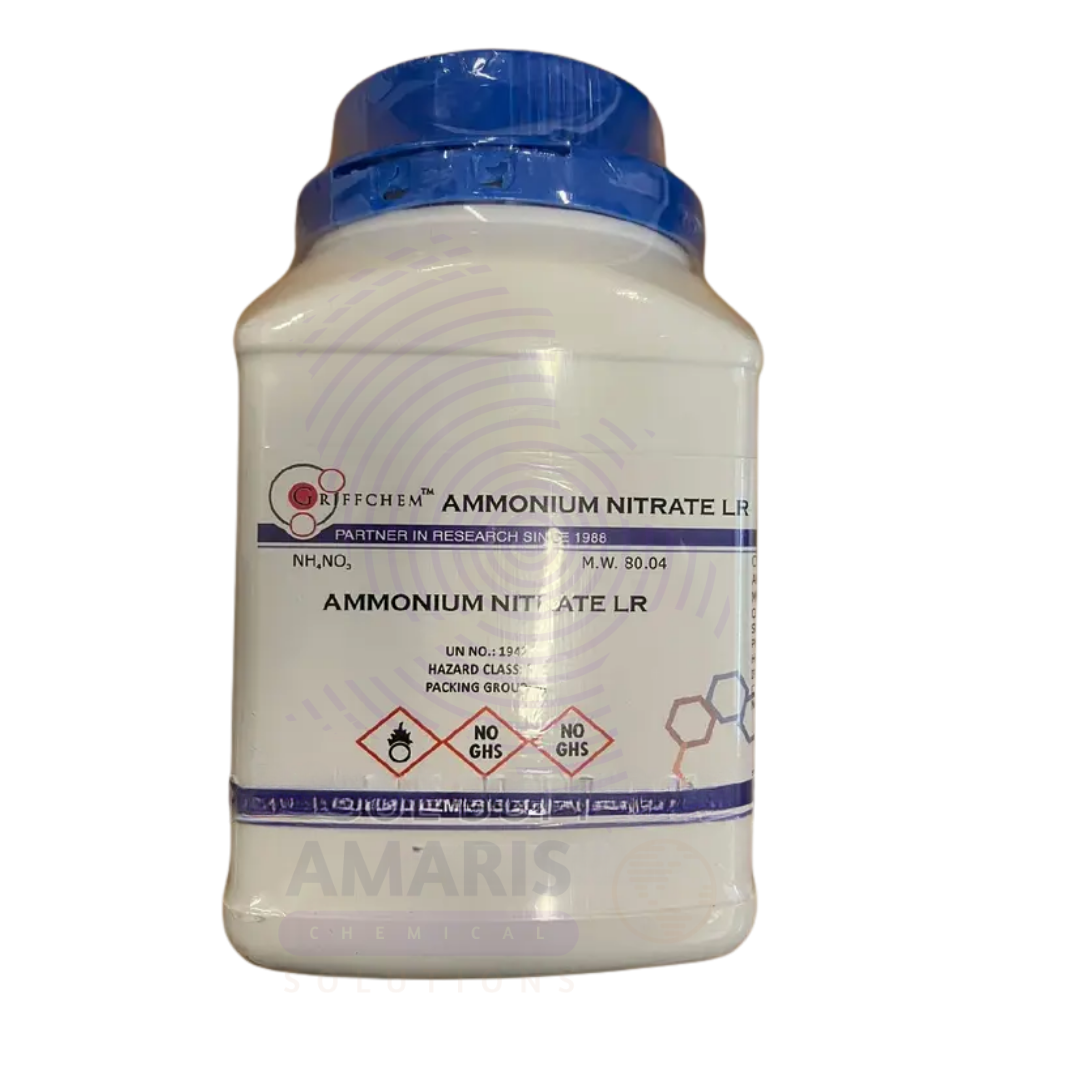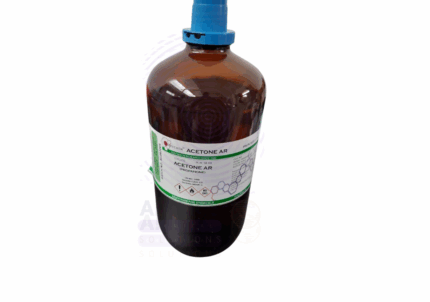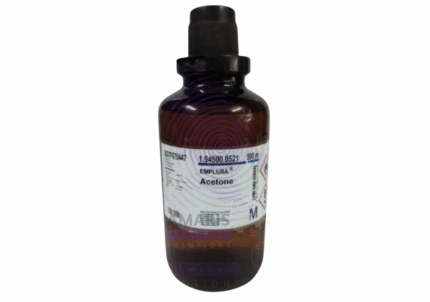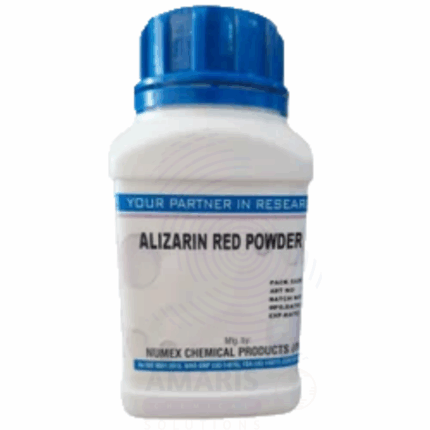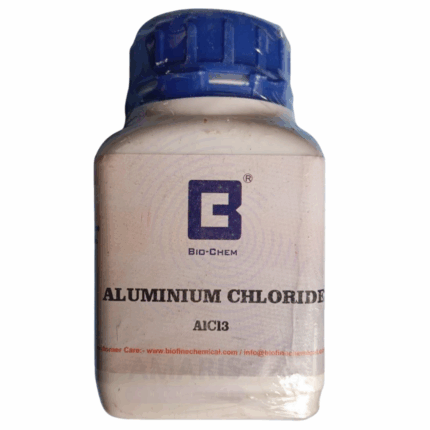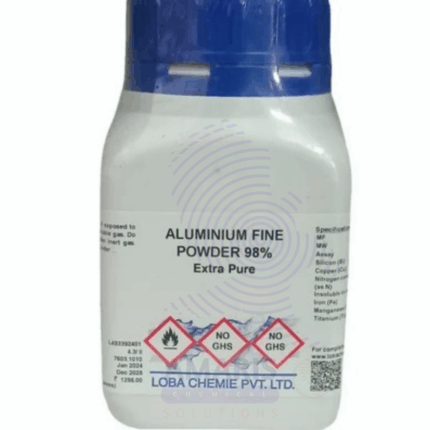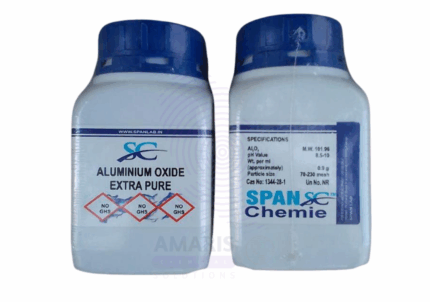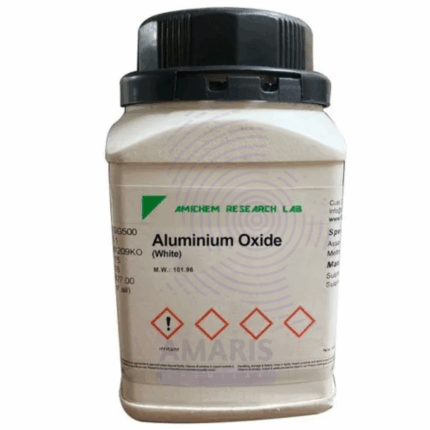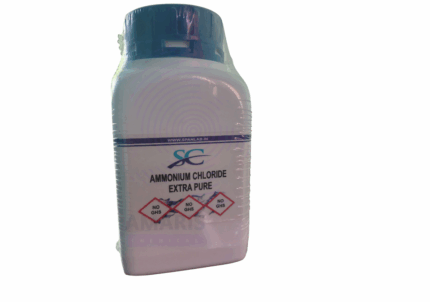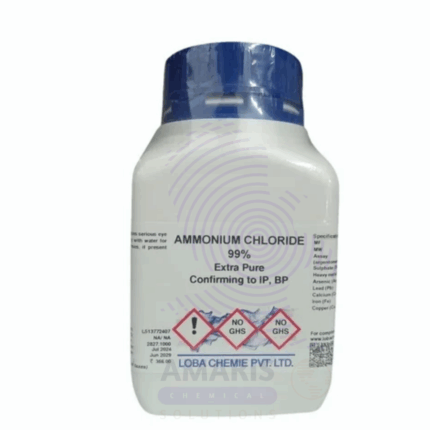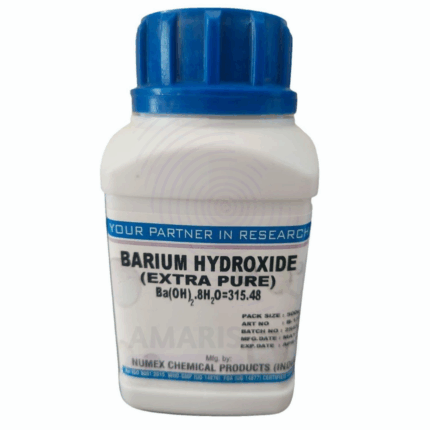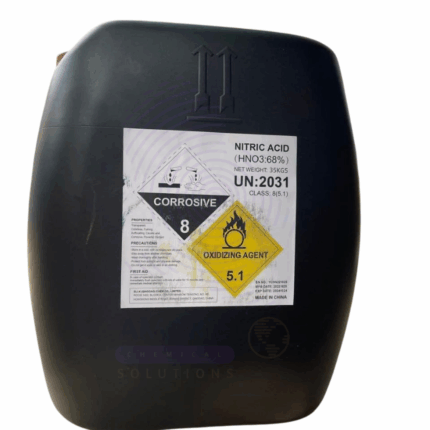Ammonium Nitrate Extra Pure
$ 18.00 Original price was: $ 18.00.$ 17.34Current price is: $ 17.34.
Ammonium Nitrate Extra Pure is a high-purity, white crystalline compound widely used in laboratory settings for analytical, inorganic, and physical chemistry applications. Known for its strong oxidizing properties, it serves as a reagent in redox reactions, thermal decomposition studies, and the synthesis of nitrate-based compounds. It is also used in preparing standard solutions and as a nitrogen source in experiments involving plant nutrition and environmental testing. Due to its hygroscopic and explosive nature under certain conditions, it must be handled with extreme caution in controlled environments. The extra pure grade ensures minimal contaminants, making it suitable for precise, high-sensitivity laboratory work. It should be stored in a cool, dry, and well-ventilated area away from heat, friction, and incompatible materials.
Ammonium Nitrate Extra Pure
Primary Uses
- Oxidizing Agent in Redox Reactions
- Acts as a strong oxidizer in controlled laboratory-scale combustion, redox titrations, and decomposition studies.
- Source of Nitrogen in Soil and Plant Chemistry Experiments
- Provides both ammonium (NH₄⁺) and nitrate (NO₃⁻) ions in nutrient analysis, hydroponic research, and simulated fertilizer behavior.
- Thermal Decomposition & Kinetics Studies
- Used to study exothermic decomposition, release of nitrogen gases, and energy changes in chemical reactions.
- Reagent for Preparation of Other Nitrate Compounds
- Supplies NO₃⁻ for synthesizing metal nitrates or for ion exchange studies in inorganic chemistry labs.
- Demonstrations of Strong Electrolyte Behavior
- Dissociates completely in water—ideal for conductivity, colligative property, or osmotic pressure studies.
Secondary Uses
- Oxidizer in Pyrotechnic or Propellant Formulation (Research Use Only)
- Sometimes studied in explosives chemistry under strictly regulated lab conditions (e.g., under license or controlled environments).
- Component in Corrosion and Metal Reactivity Experiments
- Introduced in aqueous corrosion simulations or nitrate-induced passivation studies.
- Model Compound in Environmental Pollution Studies
- Used to simulate runoff nitrate pollution, groundwater contamination, or eutrophication in ecological labs.
- Controlled Source of Nitric Oxide/Nitrogen Dioxide Gases
- Can be thermally decomposed (under strict safety protocols) to release NOₓ gases for reaction chamber studies.
- Reagent in Ammonium Ion Testing and Exchange Studies
- Applied in ion-exchange resin experiments, ammonium ion quantification, and fertilizer behavior modeling.
| PACK SIZE |
500 grams Plastic Tin |
|---|
1. Basic Identification Attributes
- Chemical Name: Ammonium Nitrate
- CAS Number: 6484-52-2
- HS Code: 31023000 (Ammonium nitrate, whether or not in aqueous solution)
- Molecular Formula: NH₄NO₃
- Synonyms:
- Nitric acid ammonium salt
- Ammonium saltpeter
- AN
- Ammonium nitricum
2. Physical & Chemical Properties
- Physical State: Solid (crystalline powder or granules)
- Color & Odor: White to off-white crystals; odorless
- Boiling Point: Decomposes before boiling
- Melting Point: ~169.6 °C
- Density/Specific Gravity: ~1.72 g/cm³
- Solubility:
- Water: Very soluble (~1920 g/L at 20 °C)
- Alcohol: Slightly soluble
- pH Level: ~4.5–6.0 (in 5% aqueous solution)
- Vapor Pressure: Negligible
- Flash Point: Not flammable, but a strong oxidizer
- Autoignition Temperature: ~210 °C (in air, variable by conditions)
- Viscosity: Not applicable
3. Safety & Hazard Attributes
- Hazard Class (GHS):
- Oxidizing Solid (Category 3)
- Eye Irritation (Category 2A)
- May intensify fire; oxidizer
- NFPA Ratings:
- Health: 2
- Flammability: 0
- Reactivity: 3
- Exposure Limits:
- No specific OSHA/ACGIH limits
- Use with proper ventilation to avoid inhalation of dust
- Reactivity:
- Strong oxidizer; reacts violently with reducing agents, organic matter, and combustibles
- Decomposes at high temperature, releasing toxic gases (nitrogen oxides, ammonia)
4. Storage & Handling Attributes
- Storage Conditions:
- Store in a cool, dry, well-ventilated, fireproof location
- Keep away from combustible materials and heat
- Incompatible Materials:
- Reducing agents, acids, bases, metals, fuels, sulfur, charcoal, organic materials
- Container Type:
- Non-metallic, corrosion-resistant, sealed containers (HDPE or glass)
- Shelf Life & Expiration Date:
- ~1–2 years in airtight container under controlled humidity
- Special Handling Requirements:
- Wear gloves, goggles, lab coat
- Avoid friction, impact, and contamination
- Do not store large quantities without proper licensing and controls
5. Regulatory & Compliance Attributes
- Regulatory Status:
- Controlled in many jurisdictions due to potential misuse (e.g. explosive precursor)
- Listed under TSCA, REACH
- Transportation Restrictions:
- UN Number: 1942
- Hazard Class: 5.1 (Oxidizer)
- Strictly regulated under ADR/IMDG/IATA for shipping
- Waste Disposal Method:
- Dissolve in water, dilute, and neutralize
- Dispose as hazardous waste via authorized facility
6. Environmental & Health Impact
- Ecotoxicity:
- Harmful to aquatic life due to eutrophication potential (nitrate runoff)
- Persistence in Environment:
- Nitrates are persistent in soil and water
- Carcinogenicity/Mutagenicity:
- Not classified as carcinogenic
- Biodegradability:
- Inorganic salt; not biodegradable, but water-soluble and environmentally mobile
SAFETY PRECAUTIONS
- Personal Protective Equipment (PPE):
- Wear a lab coat, safety goggles, and chemical-resistant gloves (nitrile or neoprene).
- Use in a fume hood or a well-ventilated area—avoid inhalation of dust.
- Handling:
- Handle with extreme care—ammonium nitrate is a powerful oxidizer.
- Avoid contamination with organic materials, metal powders, acids, reducing agents, or combustible substances—it can increase fire or explosion risk.
- Prevent dust formation and avoid physical impact or friction.
- Storage:
- Store in a cool, dry, well-ventilated place in original container.
- Keep away from heat, sunlight, and incompatible materials.
- Use explosion-proof storage where possible; label as oxidizer.
- Hygiene Measures:
- Wash hands thoroughly after handling.
- Do not eat, drink, or smoke in work areas.
- Clean work surfaces thoroughly after use.
FIRST AID MEASURES
- Inhalation:
- Move the person to fresh air immediately.
- If breathing is difficult, administer oxygen.
- Seek medical attention if symptoms like coughing or respiratory discomfort occur.
- Skin Contact:
- Rinse thoroughly with plenty of soap and water.
- Remove contaminated clothing.
- Seek medical attention if irritation develops.
- Eye Contact:
- Rinse cautiously with water for at least 15 minutes.
- Hold eyelids open and remove contact lenses if present.
- Seek immediate medical attention.
- Ingestion:
- Rinse mouth with water.
- Do not induce vomiting.
- If the person is conscious, give water to dilute.
- Seek immediate medical attention—nitrate salts can cause methemoglobinemia (oxygen transport disruption).
FIRE FIGHTING MEASURES
- Suitable Extinguishing Media:
- Use water spray in large quantities.
- Do not use dry chemicals or foam—they may be ineffective or reactive in this case.
- Specific Hazards:
- Not flammable by itself, but supports and intensifies fire due to its strong oxidizing nature.
- On heating or decomposition, releases:
- Toxic nitrogen oxides (NO, NO₂)
- Ammonia
- Protective Equipment for Firefighters:
- Wear self-contained breathing apparatus (SCBA) and full protective gear.
- Use remote fire-fighting techniques due to explosion risk in confined or heated conditions.
- Firefighting Instructions:
- Evacuate area if safe to do so.
- Cool exposed containers with water spray.
- Prevent runoff—may contaminate water and soil, harmful to aquatic life.


 Preservatives(food)
Preservatives(food) Flavor Enhancers
Flavor Enhancers Acidulants
Acidulants Sweeteners
Sweeteners Antioxidants
Antioxidants Colorants(food)
Colorants(food) Nutraceutical Ingredients (food)
Nutraceutical Ingredients (food) Nutrient Supplements
Nutrient Supplements Emulsifiers
Emulsifiers
 Collectors
Collectors Dust Suppressants
Dust Suppressants Explosives and Blasting Agents
Explosives and Blasting Agents Flocculants and Coagulants
Flocculants and Coagulants Frothers
Frothers Leaching Agents
Leaching Agents pH Modifiers
pH Modifiers Precious Metal Extraction Agents
Precious Metal Extraction Agents
 Antioxidants(plastic)
Antioxidants(plastic) Colorants (Pigments, Dyes)
Colorants (Pigments, Dyes) Fillers and Reinforcements
Fillers and Reinforcements Flame Retardants
Flame Retardants Monomers
Monomers Plasticizers
Plasticizers Polymerization Initiators
Polymerization Initiators Stabilizers (UV, Heat)
Stabilizers (UV, Heat)
 Antifoaming Agents
Antifoaming Agents Chelating Agents
Chelating Agents Coagulants and Flocculants
Coagulants and Flocculants Corrosion Inhibitors
Corrosion Inhibitors Disinfectants and Biocides
Disinfectants and Biocides Oxidizing Agents
Oxidizing Agents pH Adjusters
pH Adjusters Scale Inhibitors( water)
Scale Inhibitors( water)
 Antioxidants(cosmetic)
Antioxidants(cosmetic) Emollients
Emollients Fragrances and Essential Oils
Fragrances and Essential Oils Humectants
Humectants Preservatives
Preservatives Surfactants(cosmetic)
Surfactants(cosmetic) Thickeners
Thickeners UV Filters
UV Filters
 Fertilizers
Fertilizers Soil Conditioners
Soil Conditioners Plant Growth Regulators
Plant Growth Regulators Animal Feed Additives
Animal Feed Additives Biostimulants
Biostimulants Pesticides (Herbicides, Insecticides, Fungicides)
Pesticides (Herbicides, Insecticides, Fungicides)
 Active Pharmaceutical Ingredients (APIs)
Active Pharmaceutical Ingredients (APIs) Excipients
Excipients Solvents(pharmaceutical)
Solvents(pharmaceutical) Antibiotics
Antibiotics Antiseptics and Disinfectants
Antiseptics and Disinfectants Vaccine Adjuvants
Vaccine Adjuvants Nutraceutical Ingredients (pharmaceutical)
Nutraceutical Ingredients (pharmaceutical) Analgesics & Antipyretics
Analgesics & Antipyretics
 Analytical Reagents
Analytical Reagents Solvents(lab)
Solvents(lab) Chromatography Chemicals
Chromatography Chemicals Spectroscopy Reagents
Spectroscopy Reagents microbiology-and-cell-culture-reagents
microbiology-and-cell-culture-reagents Molecular Biology Reagents
Molecular Biology Reagents Biochemical Reagents
Biochemical Reagents Inorganic and Organic Standards
Inorganic and Organic Standards Laboratory Safety Chemicals
Laboratory Safety Chemicals Specialty Laboratory Chemicals(Special Laboratory Equipment)
Specialty Laboratory Chemicals(Special Laboratory Equipment)
 Demulsifiers
Demulsifiers Hydraulic Fracturing Fluids
Hydraulic Fracturing Fluids Scale Inhibitors(oil)
Scale Inhibitors(oil) Surfactants(oil)
Surfactants(oil) Drilling Fluids
Drilling Fluids
 Dyes and Pigments
Dyes and Pigments Bleaching Agents
Bleaching Agents Softening Agents
Softening Agents Finishing Agents
Finishing Agents Antistatic Agents
Antistatic Agents
 Admixtures
Admixtures Waterproofing Agents
Waterproofing Agents Sealants and Adhesives
Sealants and Adhesives Curing Compounds
Curing Compounds Concrete Repair Chemicals
Concrete Repair Chemicals Anti-Corrosion Coatings
Anti-Corrosion Coatings
 Surfactants(cleaning)
Surfactants(cleaning) Builders
Builders Enzymes
Enzymes Solvents (Cleaning)
Solvents (Cleaning) Fragrances
Fragrances
 Electronic Chemicals
Electronic Chemicals Catalysts
Catalysts Lubricants
Lubricants Photographic Chemicals
Photographic Chemicals Refrigerants
Refrigerants Automotive chemicals
Automotive chemicals Pyrotechnic Chemicals
Pyrotechnic Chemicals
 Biodegradable Surfactants
Biodegradable Surfactants Bio-based Solvents
Bio-based Solvents Renewable Polymers
Renewable Polymers Carbon Capture Chemicals
Carbon Capture Chemicals Wastewater Treatment Chemicals
Wastewater Treatment Chemicals
 Pigments
Pigments Solvents(paint)
Solvents(paint) Specialty Coatings
Specialty Coatings Binders/Resins
Binders/Resins Additives
Additives Driers
Driers Anti-Corrosion Agents
Anti-Corrosion Agents Functional Coatings
Functional Coatings Application-Specific Coatings
Application-Specific Coatings
 Fresh Herbs
Fresh Herbs Ground Spices
Ground Spices Whole Spices
Whole Spices Spice Blends
Spice Blends Dried Herbs
Dried Herbs
 Leavening Agents
Leavening Agents Dough Conditioners
Dough Conditioners Flour Treatments
Flour Treatments Fat Replacers
Fat Replacers Decoratives
Decoratives Preservatives(baking)
Preservatives(baking)
 Plasticizers & Softeners
Plasticizers & Softeners Reinforcing Agents
Reinforcing Agents Adhesion Promoters
Adhesion Promoters Vulcanizing Agents
Vulcanizing Agents Antidegradants
Antidegradants Blowing Agents
Blowing Agents Fillers & Extenders
Fillers & Extenders Accelerators & Retarders
Accelerators & Retarders